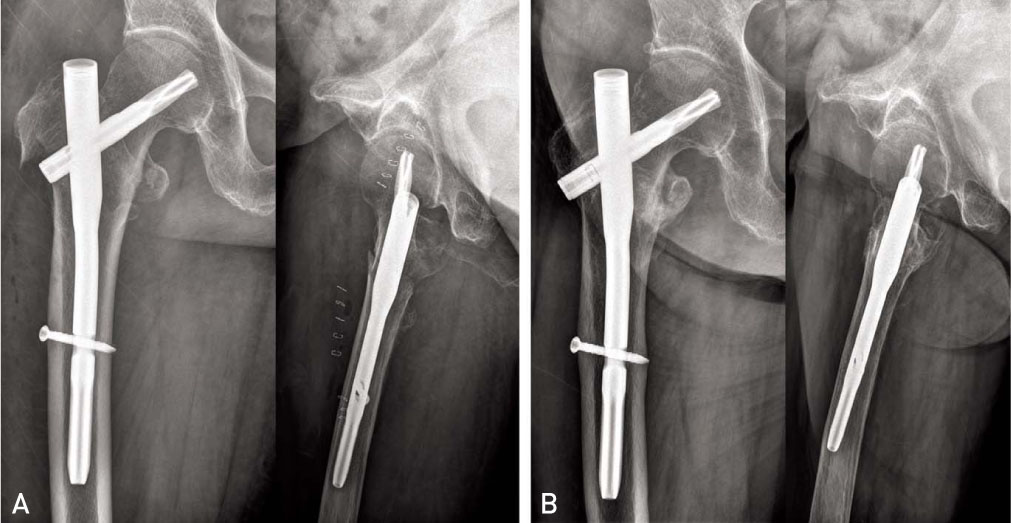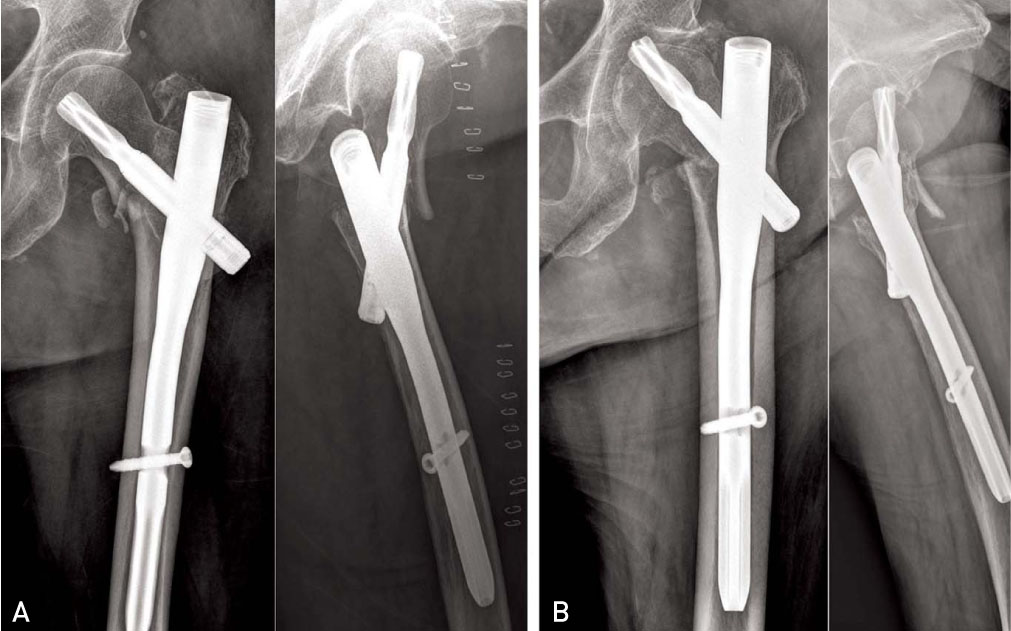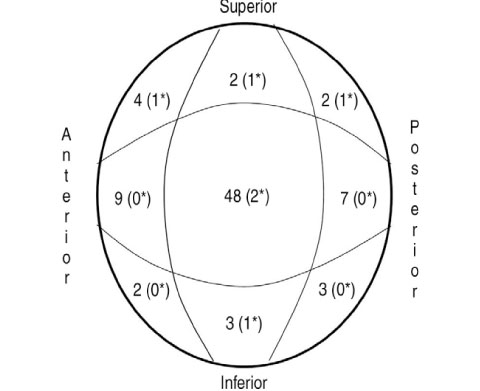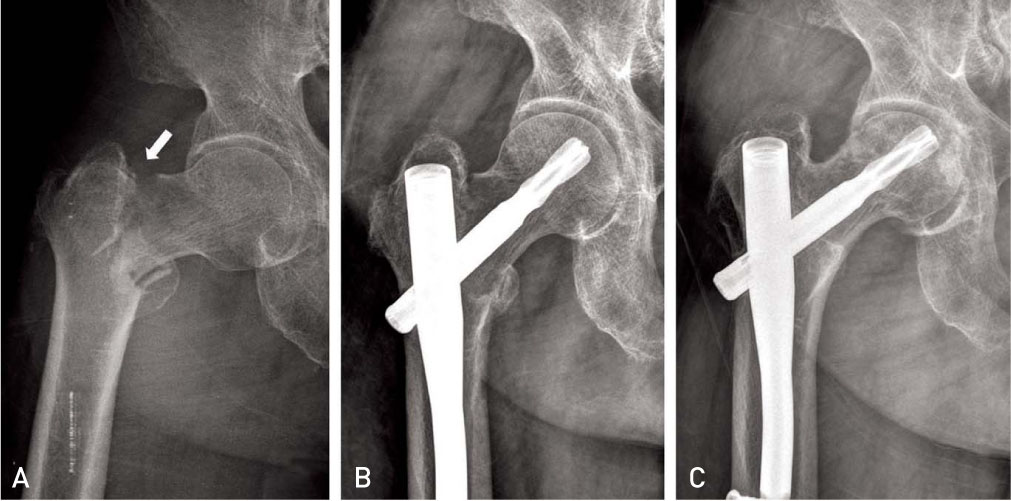Hip Pelvis.
2012 Dec;24(4):302-308. 10.5371/hp.2012.24.4.302.
Fixation Failure of Proximal Femoral Nail Anti-rotation in Femoral Intertrochanteric Fracture
- Affiliations
-
- 1Department of Orthopedic Surgery, School of Medicine, Keimyung University, Daegu, Korea. oslee@dsmc.or.kr
- KMID: 1425046
- DOI: http://doi.org/10.5371/hp.2012.24.4.302
Abstract
- PURPOSE
The aim of this study was to identify the causes of fixation failure and evaluate prophylactic methods in femoral intertrochanteric fractures treated with proximal femoral nail anti-rotation.
MATERIALS AND METHODS
Between 2006 and 2010, this study evaluated 80 cases(20 men and 60 women) of femoral intertrochanteric fracture treated with proximal femoral nail anti-rotation after a minimum follow-up of 1 year. The mean age and follow-up period was 72.6 years and 2.1 years, respectively. The factors that could affect fixation failure, such as osteoporosis, fracture pattern, reduction status and position of helical blade on the femoral head, were analyzed retrospectively.
RESULTS
Six cases of fixation failure were encountered: 4 cases of cut out of the helical blade, 1 case of excessive varus union and 1 case of hip joint pain due to the excessive sliding of helical blade. The reduction status and position of the helical blade on the femoral head showed a significant association with the fixation failure, and there were 2 cases of osteonecrosis of the femoral head at the latest follow-up.
CONCLUSION
Fixation failure was increased significantly in the case of non-anatomical reduction or superior position of helical blade in the femoral head. Therefore, the concerns related to the precise anatomical reduction and central location of the helical blade will need to be solved to reduce fixation failure.
Figure
Cited by 2 articles
-
The Antero-medial Cortex Overlapped Reduction of Unstable Intertrochanteric Fractures
Chae-Geun Kim, Suc-Hyun Kweon, Hong-Jun Han, Jae-Seon Hwang
Hip Pelvis. 2013;25(4):280-285. doi: 10.5371/hp.2013.25.4.280.Surgical Treatment of Undisplaced Femur Neck Fractures in Dementia Patients Using Proximal Femoral Nail Antirotation
Bong-Ju Park, Hong-Man Cho, Woong-Bae Min
Hip Pelvis. 2015;27(3):164-172. doi: 10.5371/hp.2015.27.3.164.
Reference
-
1. Hornby R, Evans JG, Vardon V. Operative or conservative treatment for trochanteric fractures of the femur. A randomised epidemiological trial in elderly patients. J Bone Joint Surg Br. 1989. 71:619–623.
Article2. Rochmond J, Aharonoff GB, Zuckerman JD, Koval KJ. Mortality risk after hip fracture. 2003. J Orthop Trauma. 2003. 17:S2–S5.3. White BL, Fisher WD, Laurin CA. Rate of mortality for elderly patients after fracture of the hip in the 1980's. J Bone Joint Surg Am. 1987. 69:1335–1340.
Article4. Sommers MB, Roth C, Hall H, et al. A laboratory model to evaluate cutout resistance of implants for pertrochanteric fracture fixation. J Orthop Trauma. 2004. 18:361–368.
Article5. Steinberg GG, Desai SS, Kormwitz NA, Sullivan TJ. The intertrochanteric hip fractire. A retrospective analysis. Orthopedics. 1988. 11:265–273.
Article6. Strauss E, Frank J, Lee J, Kummer FJ, Tejwani N. Helical blade versus sliding hip screw for treatment of unstable intertrochanteric hip fracture: a biomechanical evaluation. Injury. 2006. 37:984–989.
Article7. Simmermacher RK, Ljungqvist J, Bail H, et al. The new proximal femoral nail antirotation (PNFA) in daily practive: results of a multicentre clinical study. Injury. 2008. 39:932–939.
Article8. Tang P, Hu F, Shen J, Zhang L, Zhang L. Proximal femoral nail antiroationa versus hemiarthroplasty: a study for the treatment of intertrochanteric fractures. Injury. 2012. 43:876–881.
Article9. Jensen JS. Classification of trochanteric fractures. Acta Orthop Scand. 1980. 51:803–810.
Article10. Madsen JE, Naess L, Aune AK, Alho A, Ekeland A, Strømsøe K. Dynamic hip screw with trochanteric stabilizing plate in the treatment of unstable proximal femoral fractures: a comparative study with the Gamma nail and compression hip screw. J Orthop Trauma. 1998. 12:241–248.
Article11. Rha JD, Kim YH, Yoon SI, Park TS, Lee MH. Factors affecting sliding of the lag screw in intertrochanteric fractures. Int Orthop. 1993. 17:320–324.
Article12. Thomas AP. Dynamic hip screws that fail. Injury. 1991. 22:45–46.
Article13. Parker MJ. Trochanteric hip fractures. Fixation failure commoner with femoral medialization, a comparison of 101 cases. Acta Orthop Scand. 1996. 67:329–332.
Article14. Hardy DC, Descamps PY, Krallis P, et al. Use of an intramedullary hip-screw compared with a compression hip-screw with a plate for intertrochanteric femoral fractures. A prospective, randomized study of one hundred patients. J Bone Joint Surg Am. 1998. 80:618–630.
Article15. Cleveland M, Bosworth DM, Thompson FR, Wilson HJ Jr, Ishizuka T. A ten-year analysis of intertrochanteric fractures of the femur. J Bone Joint Surg Am. 1959. 41-A:1399–1408.
Article16. Doppelt SH. The sliding compression screw--today's best answer for stabilization of intertrochanteric hip fractures. Orthop Clin North Am. 1980. 11:507–523.
Article17. Jensen JS. Trochanteric fractures. An epidemiological, clinical and biomechanical study. Acta Orthop Scand Suppl. 1981. 188:1–100.18. Mulholland RC, Gunn DR. Sliding screw plate fixation of intertrochanteric femoral fractures. J Trauma. 1972. 12:581–591.
Article19. Gundle R, Gargan MF, Simpson AH. How to minimize failures of fixation of unstable intertrochanteric fractures. Injury. 1995. 26:611–614.
Article20. Suh DH, Han SB, Kang JW. Analysis and management of failed intertrochanteric fracture fixation. J Korean Hip Soc. 2007. 19:82–88.
Article21. Davis TR, Sher JL, Horsman A, Simpson M, Porter BB, Checketts RG. Intertrochanteric femoral fractures. Mechanical failure after internal fixation. J Bone Joint Surg Br. 1990. 72:26–31.
Article22. Laros GS, Moore JF. Complications of fixation in intertrochanteric fractures. Clin Orthop Relat Res. 1974. (101):110–119.23. Nunn D. Sliding hip screw and medial displacement osteotomy. J R Soc Med. 1988. 81:140–142.
Article24. Kyle RF, Gustilo RB, Premer RF. Analysis of six hundred and twenty-two intertrochanteric hip fractures. J Bone Joint Surg Am. 1979. 61:216–221.
Article25. Min BW, Cho YS, Lee JH, Song KS, Cho CH. Avascular necrosis of the femoral head after intertrochanteric fracture. J Korean Hip Soc. 2006. 18:486–492.
Article26. Baixauli EJ, Baixauli F Jr, Baixauli F, Lozano JA. Avascular necrosis of the femoral head after intertrochanteric fractures. J Orthop Trauma. 1999. 13:134–137.
Article
- Full Text Links
- Actions
-
Cited
- CITED
-
- Close
- Share
- Similar articles
-
- Excessive Sliding of the Helical Blade and the Femoral Neck Fracture after Insertion of Proximal Femoral Nail Anti-Rotation for Type A2 Intertrochanteric Fractures - A Case Report -
- Comparative Study of Intertrochanteric Fracture Treated with the Proximal Femoral Nail Anti-Rotation and the Third Generation of Gamma Nail
- Osteolysis Around the Distal Targeting Screw after Using Proximal Femoral Nail Anti-Rotation for Intertrochanteric Fractures
- Fixation Failure after internal Fixation in Intertrochanteric Fractures
- Femoral Neck Fracture After Removal of the Intramedullary Nail for the Fixation of an Intertrochanteric Fracture: Report of 2 Cases





